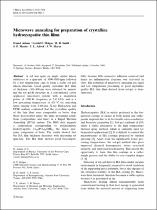JavaScript is disabled for your browser. Some features of this site may not work without it.
- ResearchSpace
- →
- Research Publications/Outputs
- →
- Journal Articles
- →
- View Item
| dc.contributor.author |
Adams, D

|
|
| dc.contributor.author |
Malgas, GF

|
|
| dc.contributor.author |
Smith, RD

|
|
| dc.contributor.author |
Massia, SP

|
|
| dc.contributor.author |
Alford, TL

|
|
| dc.contributor.author |
Mayer, JW

|
|
| dc.date.accessioned | 2007-06-12T07:39:48Z | |
| dc.date.available | 2007-06-12T07:39:48Z | |
| dc.date.issued | 2006-11 | |
| dc.identifier.citation | Adams, D, et al. 2006. Microwave annealing for preparation of crystalline hydroxyapatite thin films. Journal of Materials Science, vol. 41(21), pp 7150-7158 | en |
| dc.identifier.issn | 0022-2461 | |
| dc.identifier.uri | http://hdl.handle.net/10204/558 | |
| dc.description | Copyright: 2006 Springer | en |
| dc.description.abstract | A sol was spun on single crystal silicon substrates at a spin-rate of 3000–5000 rpm followed by a low temperature cure to form a stable sol–gel/ silicon structure. Good quality crystalline HA films of thickness ~300–400 nm were obtained by annealing the sol–gel/Si structure in a conventional cavity applicator microwave system with a magnetron power of 1300 W, frequency of 2.45 GHz, and at a low processing temperature of 425°C for annealing times ranging from 2–60 min. X-ray Diffraction and FTIR analysis confirmed that the crystalline quality of the thin films were comparable or better than those heat-treated under the same processing conditions (temperature and time) in a Rapid Thermal Annealing (RTA) system. The RBS data suggests a composition corresponding to stoichiometric hydroxyapatite Ca10(PO4)6(OH)2, the major inorganic component of bone. The results showed that the HA film thickness decreases with increasing sol spin-rate. The HA films showed good biocompatibility because little monocyte adhesion occurred and hence no inflammatory response was activated in vitro. The potential of microwave annealing for rapid and low temperature processing of good crystalline quality HA thin films derived from sol–gel is demonstrated. | en |
| dc.language.iso | en | en |
| dc.publisher | Springer | en |
| dc.subject | Crystalline hydroxyapatite | en |
| dc.subject | Microwave annealing | en |
| dc.subject | HA thin films | en |
| dc.subject | Sol-gel - silicon structures | en |
| dc.subject | Crystal silicon substrates | en |
| dc.subject | Materials sciences | en |
| dc.title | Microwave annealing for preparation of crystalline hydroxyapatite thin films | en |
| dc.type | Article | en |
| dc.identifier.apacitation | Adams, D., Malgas, G., Smith, R., Massia, S., Alford, T., & Mayer, J. (2006). Microwave annealing for preparation of crystalline hydroxyapatite thin films. http://hdl.handle.net/10204/558 | en_ZA |
| dc.identifier.chicagocitation | Adams, D, GF Malgas, RD Smith, SP Massia, TL Alford, and JW Mayer "Microwave annealing for preparation of crystalline hydroxyapatite thin films." (2006) http://hdl.handle.net/10204/558 | en_ZA |
| dc.identifier.vancouvercitation | Adams D, Malgas G, Smith R, Massia S, Alford T, Mayer J. Microwave annealing for preparation of crystalline hydroxyapatite thin films. 2006; http://hdl.handle.net/10204/558. | en_ZA |
| dc.identifier.ris | TY - Article AU - Adams, D AU - Malgas, GF AU - Smith, RD AU - Massia, SP AU - Alford, TL AU - Mayer, JW AB - A sol was spun on single crystal silicon substrates at a spin-rate of 3000–5000 rpm followed by a low temperature cure to form a stable sol–gel/ silicon structure. Good quality crystalline HA films of thickness ~300–400 nm were obtained by annealing the sol–gel/Si structure in a conventional cavity applicator microwave system with a magnetron power of 1300 W, frequency of 2.45 GHz, and at a low processing temperature of 425°C for annealing times ranging from 2–60 min. X-ray Diffraction and FTIR analysis confirmed that the crystalline quality of the thin films were comparable or better than those heat-treated under the same processing conditions (temperature and time) in a Rapid Thermal Annealing (RTA) system. The RBS data suggests a composition corresponding to stoichiometric hydroxyapatite Ca10(PO4)6(OH)2, the major inorganic component of bone. The results showed that the HA film thickness decreases with increasing sol spin-rate. The HA films showed good biocompatibility because little monocyte adhesion occurred and hence no inflammatory response was activated in vitro. The potential of microwave annealing for rapid and low temperature processing of good crystalline quality HA thin films derived from sol–gel is demonstrated. DA - 2006-11 DB - ResearchSpace DP - CSIR KW - Crystalline hydroxyapatite KW - Microwave annealing KW - HA thin films KW - Sol-gel - silicon structures KW - Crystal silicon substrates KW - Materials sciences LK - https://researchspace.csir.co.za PY - 2006 SM - 0022-2461 T1 - Microwave annealing for preparation of crystalline hydroxyapatite thin films TI - Microwave annealing for preparation of crystalline hydroxyapatite thin films UR - http://hdl.handle.net/10204/558 ER - | en_ZA |






